Moving averages are simple but effective tools for deciphering complex price trends. They complement other market indicators when used correctly. This guide covers moving averages in detail, including their types, relevance in crypto trading, and how to pair them with other indicators for better confirmations.
KEY TAKEAWAYS
➤ Moving averages are essential tools for tracking crypto price trends over various timeframes.
➤ Different types of moving averages (SMA, EMA, WMA) suit different trading strategies and goals.
➤ Crossovers, like the golden cross, provide strong signals for potential trend reversals in crypto.
Understanding moving averages
Moving averages simplify crypto trading by smoothing out price fluctuations. In the highly volatile cryptocurrency market, price data can be hard to track over both short and long-term periods. Moving averages make these trends clearer.
What is a moving average indicator?
➤ Moving average (MA) is a lagging, trend-following technical analysis tool that relies on past prices. Moving averages smooth out price data for easy interpretation.
An interesting thing about them is that moving averages can be used on a wide range of timeframes, depending on your trading preferences. As tools, MAs help visualize the price action of an asset over time.
Moving averages aren’t just limited to crypto.
Each MA is represented as a single line and can be used to predict upcoming price trends, but only after the trend has already started.
A simple way of looking at a moving average is to add up the closing prices of a given asset for a predetermined period. Once done, the sum is divided by that period — the number of days or hours you want to interpret the moving average against.
➤ For instance, a five-day simple moving average (SMA) is about adding up the closing prices for the last five days and then dividing the same by five.
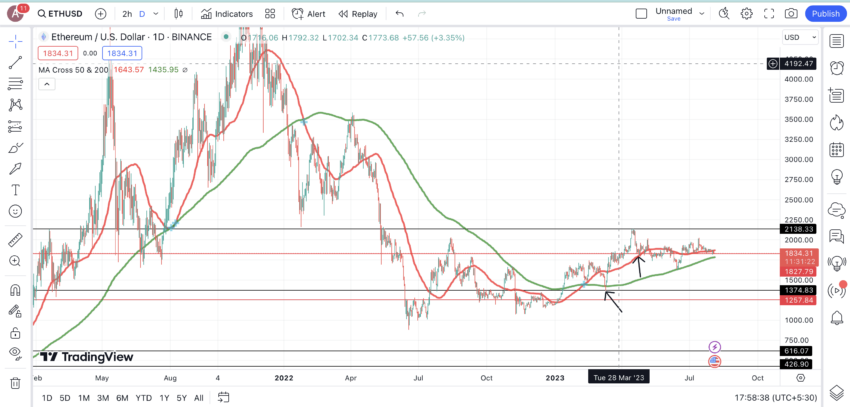
The data will be interpreted and represented as a smoothed-out line, showing the assets’ trading direction.
➤ In the cryptocurrency market, there is no concept of closing price as the market never sleeps. In that scenario, a specific time over the course of 24-hours is taken into account, and the price at that time every day is regarded as the closing price. This reference time, which might be different for different platforms, is represented by the Coordinated Universal Time (UTC) standard and is essentially similar to GMT or Greenwich Mean Time.
For shorter timeframes, such as hourly or minute charts, the moving average is calculated using the last traded price within the selected period.
Other examples of how moving averages work
The best to understand moving averages is to consider how they are used for Bitcoin trading.
For instance, let’s pick a random timeline between November 2021 and August 2023. From the correction following the highs of November 2021, the price of BTC remained volatile between June 2022 to July 2023, continuing even into August 2023. There were some sharp moves on the upside but no clear trend.
However, if we apply the right moving average, 200-day SMA — which takes price data for the last 200 days — in the case of Bitcoin, the trend till March 2023 seems bearish.
After that, it seems that Bitcoin is gaining strength. Do note that we used the 200-day moving averages here as longish timeframes are good for making long-term trading decisions. You can even use the 50-day moving average to see how the prices fluctuated in shorter spurts.
Here is a reason why important moving average levels are worth tracking:
“Bitcoin has breached the 50-day moving average! This is a rare event. In 2017 it only happened a few times. And every time was a legend making dip buying opportunity.”
Lark Davis, crypto trader: Twitter
The moving average formula
In trading parlance, two types of moving averages are usually used: simple moving averages (SMA) and exponential moving averages (EMA).
The calculation formula for each is as follows:
➤ For SMA:
SMA = (A1 + A2 + A3 + … + An) / n,
Where A1, A2, …An etc. stand for the closing prices for every given period till n.
For instance, if you want to calculate the 7-day simple moving average, then n = 7. In the case of an SMA, all the prices within the time range are equally weighted.
➤ For EMA:
EMA = (close – previous day’s EMA) * (2/(selected time period + 1)) + previous day’s EMA
This kind of moving average is not equally weighted and is skewed toward recent data.
Why do we use moving averages?
Besides being a relatively simple indicator to use, here are some of the other reasons to use moving averages:
- To act as support and resistance levels along with the usual trend lines and horizontal lines, helping with grid trading and stop loss placements.
- To help with trend identification. Prices trading above long-term moving average lines are presumed to be in an uptrend or on the verge of assuming an uptrend.
- To offer specific trading signals to traders using two or more moving average lines. This can be something like a golden cross or a death cross. We shall come to that later in this discussion.
Types of moving averages
There are quite a few types of moving averages, allowing you to use them across a wide range of trading scenarios.
Simple moving average (SMA)
We discussed the formula to calculate the simple moving average (SMA) earlier. Just to reiterate, this type gives equal weightage to every price within the range.
If you want to explore long-term crypto trends or asset class trends, SMAs make more sense as they capture things without bias. Simple moving averages are minimally reactive to short-term price fluctuations and are simple to use.
Exponential moving average (EMA)
SMAs can be a tad slow when reacting to recent price changes as they give equal weightage to every price point. EMAs are better in that regard as they prioritize recent data points.
This means that they make more sense in short-term trading scenarios like day trading, scalping, and swing trading.
Also, EMAs are better at predicting trend reversals and any other trading signal quicker than SMAs. However, EMAs can also give out more false signals in a market that’s trading sideways due to the higher responsiveness.
Weighted moving average (WMA)
EMAs assign weights to data points exponentially, whereas weighted moving average (WMA) does that in a linear way. Here is what the formula looks like:
WMA = (P1*5 + P2*4 + P3*3 + P4*2 + P5*1) / (5+4+3+2+1)
Where:
- P1 = Recent day price
- P2 = Price of the day before P1
- P3, P4, P5 = Prices of the 3rd, 4th, and 5th days
Do note that P1 has the most weightage, i.e., five, and P5 has the least weightage, i.e. 1.
WMA is used when you still need to prioritize recent prices minus the sensitivity that the EMA brings. This can help reduce the chances of getting a false trading signal.
While SMAs are great tools for long-term market analysis, both EMAs and WMAs are meant for fast-moving trading scenarios.
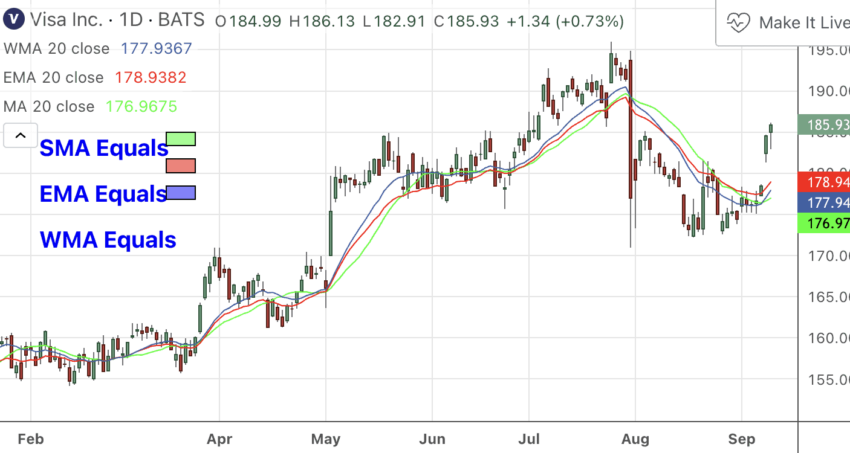
Which moving average is best for crypto?
Like other markets, the crypto market also regularly presents a wide range of unique trading scenarios. But worry not; you can use different moving average combinations to simplify your trading strategy.
Moving averages for scalping
Short-term trades or scalps include looking at shorter timeframes to place multiple daily orders. And to make scalping work, very small-period trading moving averages make sense.
➤ The 5-8-13 EMA strategy is best as it can help react to the smallest of price changes.

Here are some of the strategies used by scalpers to make better trades:
- Using the concept of price crossovers, the short-term price candle crossing above the short-term moving average might be a bullish sign.
- Using the concept of multiple moving averages where the shorter-term EMA, say the 5-period EMA crossing above the longer-term EMA, say the 8-period EMA, can be considered bullish.
Moving averages for day trading
Day trading strategies differ from scalping as traders often need to look for both long-term and short-term trading signals to take calls.
The idea here is to use short-term MAs like the 10-period or even 20-period EMAs to gauge the recent trend or chances of reversal. These can be used in addition to long-term EMAs or even SMAs like 50-period or 200-period to understand the broader market conditions.
In case you are using the daily chart, the “period” stands for days — meaning 200-period moving averages — taking prices of 200 days into account.
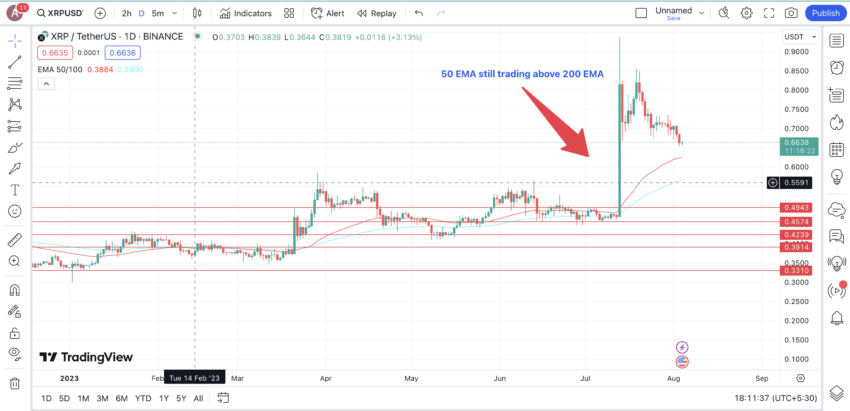
Do note that you can use these multiple moving average combinations on almost any timeframe.
As for the strategies, here are the most popular day trading ones using moving averages:
- Using moving averages as dynamic levels for locating support and resistance.
- Using moving average crossover (s) to determine bullishness or bearishness.
Moving averages for swing trading
In swing trading, assets are held precisely for days or even weeks to capture the right price swings. And this is where 50-period and 200-period moving averages come in most handy.
For instance, if you see both 50-period and 200-period moving averages surge higher, it might indicate a bullish trend.
➤ As swing trades take place over a period of a few days, it is better to use SMAs instead of EMAs to capture the right trading signals.

As for trading strategies, you can follow the same ones as day trading — using the MAs as support and resistance levels or using multiple MAs to locate crossovers.
Here is a quick tip to utilize shorter time period MAs better for swing trading:
“Once the stock successfully breaks out, the stock price should hold its 20-day moving average and, in most cases, should not close below it.”
Mark Minervini, author of the Stock Market Wizard: Twitter
Moving averages in-depth
You would have seen a few mentions of moving average crossovers. Well, a moving average crossover is nothing complex, and we shall now delve deeper to understand what it means for your crypto trading gigs.
Unpacking the golden cross and death cross
A golden cross is a bullish signal that surfaces when a shorter-term moving average crosses above the longer-term moving average.
This crossover form indicates a shift from sideways market conditions or, rather, bearish market conditions to bullish ones. The golden cross indicates that buyers are slowly taking control. This is where accumulating and entering long might make sense.
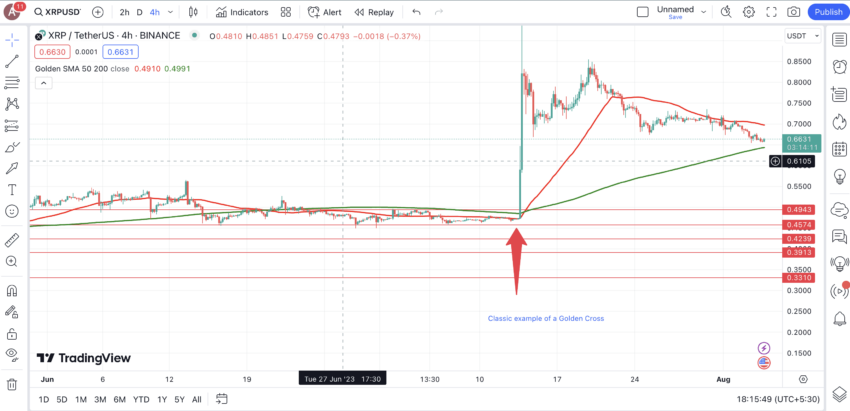
The inverse of this, i.e., the death cross, is also true. This happens when the longer-term MA crosses above the shorter-term MA. This indicates growing bearishness, which might favor short positions and even lead to falling knife patterns with sharper dips to experience.
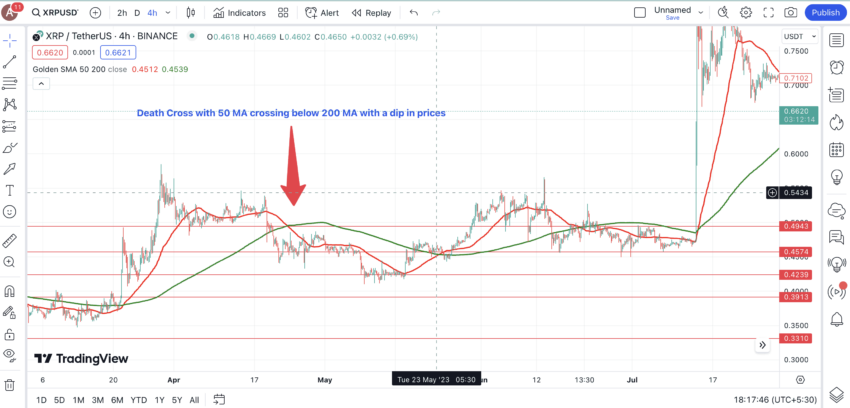
And while different moving average combinations can be used for locating golden cross and death cross scenarios, 200-period and 50-period moving averages offer the most credible signs.
These MAs strike the perfect balance between short-term and long-term scenarios.
How to use 5-8-13 EMA
As a scalper, a day trader, or a trader looking for proactive trading signals and arbitrage opportunities, the 5-8-13 EMA strategy works like a charm.
However, these numbers aren’t chosen randomly. These are Fibonacci numbers that follow a set ratio and complement each other. Therefore, they work wonderfully when it comes to acting as short-term support or resistance levels.
Meanwhile, looking for crossovers is often the best way to use this trading tool. The 5-period EMA — the one that prioritizes recent prices over everything else — crossing over the 8-period EMA and 13-period EMA lines signifies bullishness.
Similarly, if the 5-period EMA falls under the other two EMA lines, you can expect a sell-off across the market.
➤ Do note that the 5-8-13 EMA approach is best for trending markets. It might lead to false trading signals in a consolidating market.
Time periods in moving averages
Have you ever tried to pit short-term moving average lines like the 10-period or even 20-period MA lines against the likes of 100-period or even 200-period lines?
You will notice that the shorter-term MA will fluctuate more than the latter. The reason here is the heightened sensitivity associated with shorter-term MAs.
And this is what the significance of the time period is. If you are a short-term trader who prefers quick signals and quicker hauls, anything less than the 50-period moving average makes sense. You might even want to consider EMAs instead of SMAs for added sensitivity.
However, bigger time periods are preferred for an extended market view.
It is worth noting that the moving average time period isn’t the same as the chart timeframe you use. The chart timeframe lets you in on the view of the price action.
Regardless of the chart timeframe, you can use any moving average to gauge market conditions. For instance, you might have a four-hour chart open and still want to use the 50-period and 200-period moving averages to locate crossovers. And here, the “period” part is four hours.
Indicators that work best with MA?
Even though moving averages are quite credible, they work even better when paired with relevant indicators. Here are some of the additional indicators that work best with MAs:
Relative strength index (RSI)
As a momentum oscillator, the RSI works very well with moving averages. Here is how the trading strategy might work:
You can see if the price movements are above a given moving average, say the 50-day MA, giving a hint of bullishness. If that happens, you can confirm the bullishness by seeing if the RSI is in the oversold region or not — below 40 from a conservative approach. (Do note that 30 isn’t always achievable, and hence we decided to go with 40).
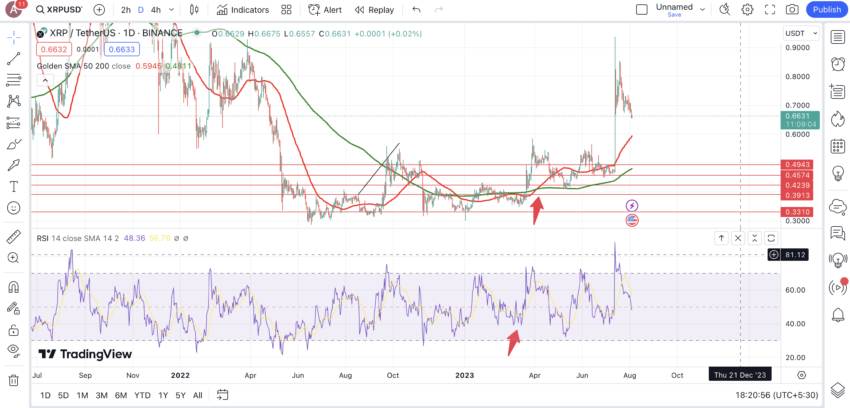
You can also check for RSI divergences, bullish or bearish, for stronger confirmations. Also, RSI can confirm death and golden cross events, adding the needed validation to trend reversals.
Volume-weighted average price
This is a scalping-focused indicator that works well with the 5-8-13 EMA trading strategy. To make it work, you need to first check for a bullish crossover, where the 5-period EMA crosses above the others.
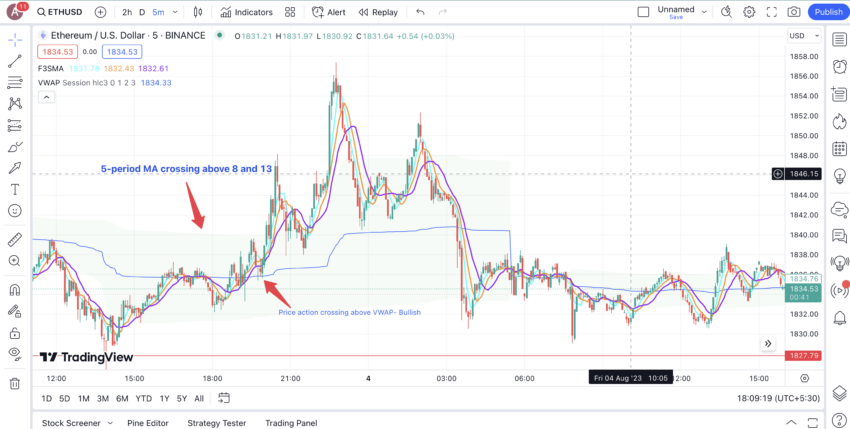
Once that is achieved, the price movements above the VWAP confirm a strong trading signal. The inverse of this, with the 5-period EMA crossing below others, also holds. The price needs to move below the VWAP line for that to hold.
Bollinger bands
Bollinger bands serve as a volatility indicator, with the middle band being the 20-period simple moving average. This reference point can be used to identify the future movement of the cryptocurrency.
If the price nears the upper band, the asset might correct, due to it being in the overbought territory. Similarly, if it moves towards the lower band, it is presumed to be in the overbought territory. This might be indicative of a price rise.
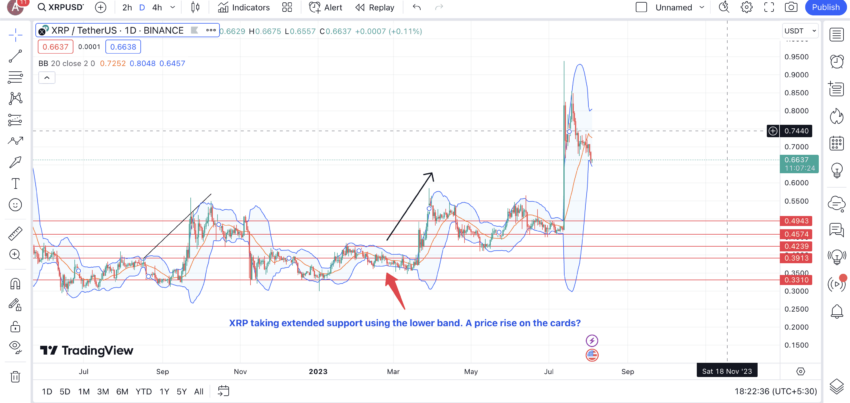
Moving average convergence-divergence (MACD)
The entire concept of MACD hinges on moving averages. As a trend-following indicator, MACD is calculated when subtracting the 26-period EMA and the 12-period EMA.
However, this calculation, when smoothed out, gives the MACD line. Then there is the signal line, which is the 9-period EMA of the MACD line.

This complex combination gives the following insights:
- When MACD crosses above the signal line, it might be a bullish trading signal.
- When MACD crosses below the signal line, it might be a bearish trading signal.
- For added validation, you can use the 200-period and 50-period EMA lines on the price chart.
A potent tool for technical analysis
As seen throughout this guide, moving averages are highly self-sufficient crypto trading indicators. The concept works well for both beginners and experienced traders. Plus, their usefulness extends from long-term trading to short-term hauls.
However, utilizing moving averages for crypto trading, especially with supplemental indicators, takes practice. And unlike any other crypto trading tool, even they are prone to failures. That is why a proper risk management strategy is necessary, regardless of how you trade.
Frequently asked questions
What is the moving average formula in crypto?
Which is better, SMA or EMA?
Which moving average is better?
What are moving average examples?
What is the formula for the moving average?
What is called the moving average?
Why do we use moving averages?
Is the moving average a good indicator?
Disclaimer
In line with the Trust Project guidelines, the educational content on this website is offered in good faith and for general information purposes only. BeInCrypto prioritizes providing high-quality information, taking the time to research and create informative content for readers. While partners may reward the company with commissions for placements in articles, these commissions do not influence the unbiased, honest, and helpful content creation process. Any action taken by the reader based on this information is strictly at their own risk. Please note that our Terms and Conditions, Privacy Policy, and Disclaimers have been updated.




